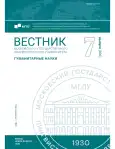Robin Hood in the Mirror of the Reformation: Transformation of the Image During the Elizabethan and Jacobean Eras
- Authors: Kolosova E.I.1
-
Affiliations:
- Institute of Scientific Information for Social Sciences of the Russian Academy of Sciences
- Issue: No 7(901) (2025)
- Pages: 114-121
- Section: Literary criticism
- URL: https://ogarev-online.ru/2542-2197/article/view/303329
- ID: 303329
Cite item
Full Text
Abstract
In light of the traditional view of Robin Hood as a symbol of the Yeomanry, the idea of his noble origins at the end of the Elizabethan era and the beginning of the Jacobean era deserves further exploration. Using comparative historical and literary-historical methods, this article attempts to identify the reasons for such a radical transformation of this image by examining two plays by the English playwright Anthony Munday (1560–1633) – The Downfall of Robert, Earl of Huntington (1601) and The Death of Robert, Earl of Huntington (1601). By making Robin Hood the central figure of these plays, the playwright not only honored his first mentor but also highlighted the enduring universality of this image within a historical context, while using it as a lens to explore the urgent issues of his era.
About the authors
Ekaterina Igorevna Kolosova
Institute of Scientific Information for Social Sciences of the Russian Academy of Sciences
Author for correspondence.
Email: kolosova@inion.ru
PhD (Philology), Researcher, Department of Literary Studies
Russian FederationReferences
- Hutton, R. (1996). The Stations of the Sun: A History of the Ritual Year in Britain. London: Oxford University Press.
- Simeone, W. E. (1951). The May Games and the Robin Hood Legend. Journal of American Folklore, 64, 265–274.
- Barczewski, S. (2000). Myth and National Identity in Nineteenth-Century Britain: The Legends of King Arthur and Robin Hood. London: Oxford University Press.
- Latimer, H. (1869). Seven Sermons before Edward VI, on Each Friday in Lent, 1549. Ed. by E. Arber. London: Alex Murray & Son.
- Tyndale, W. (2000). The Obedience of a Christian Man. London: Penguin Classics.
- Knight, S. (2013). Robin Hood in Greenwood Stood: Alterity and Context in the English Outlaw Tradition. Turnhout: Brepols.
- Knight, S. (Ed.). (1999). Robin Hood: An Anthology of Scholarship and Criticism. Martlesham: Boydell & Brewer Ltd.
- Hall, E. (1809). Hall’s Chronicle: Containing the History of England, During the Reign of Henry the Fourth, and the Succeeding Monarchs, to the End of the Reign of Henry the Eighth. London: J. Johnson.
- Munday, A. (1997). The Downfall of Robert, Earle of Huntington. In Knight, S., Ohlgren, T. H. (Eds.), Robin Hood and Other Outlaw Tales (pp. 303–402). Michigan: Medieval Institute Publications.
- Munday, A. (1997). Excerpts from The Death of Robert, Earle of Huntington. In Knight, S., Ohlgren, T. H. (Eds.), Robin Hood and Other Outlaw Tales (pp. 402–441). Michigan: Medieval Institute Publications.
- Dobson, R. B., Taylor, J. (1976). Rymes of Robyn Hood: An Introduction to the English Outlaw. London: Heinemann.
- Ritson, J. (1795). Robin Hood: A Collection of All the Ancient Poems, Songs, and Ballads, Now Extant, Relative to That Celebrated English Outlaw: To Which Are Prefixed Historical Anecdotes of His Life. London: T. Egerton, J. Johnson.
- Hunter, J. (1852). The Great Hero of the Ancient Minstrelsy of England, "Robin Hood.": His Period, Real Character, Etc. Investigated and Perhaps Ascertained. London: J. R. Smith.
- Walker, J. W. (1944). Robin Hood Identified. Yorkshire Archaeological Journal, 36, 4–46.
- Transcript of the Registers of the Company of Stationers of London 1554–1640. (1950). Arber, E. (Ed.). N.Y.: P. Smith Co.
- Munday, A. (1579). The Mirrour of Mutabilitie, Or Principall Part of the Mirrour for Magistrates: Describing the Fall of Divers Famous Princes, and Other Memorable Personages. Lond0on: John Allde.
- Wilson, J. D. (1909). Anthony Munday, Pamphleteer and Pursuivant. The Modern Language Review, 4(4), 484–490.
- Wright, C. T. (1959). Young Anthony Munday Again. Studies in Philology, 56(2), 150–168.
- McCoog, T. M. (1993). The Flower of Oxford: the Role of Edmund Campion in Early Recusant Polemics. The Sixteenth Century Journal, 24(4), 899–913.
- Meagher, J. C. (1966). Hackwriting and the Huntingdon Plays. In Brown, J. R., Harris, B. (Eds.), Elizabethan Theatre (pp. 197–219). London: Edward Arnold Publishers Ltd.
- Kolosova E. I. (2023). The Past as a Way to Talk About the Present: “Robin Hood: a Collection of All Ancient Poems, Songs and Ballads that Have Survived to the Present Day” By J. Ritson. Vestnik Pyatigorskogo gosudarstvennogo universiteta, 3, 100–104. (In Russ.)
Supplementary files










